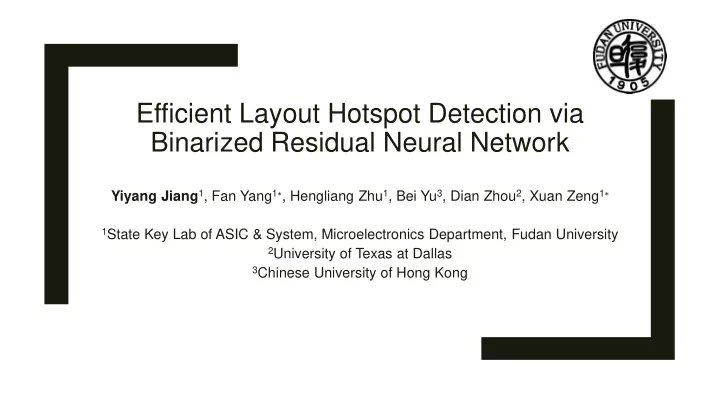

Efficient Layout Hotspot Detection via Binarized Residual Neural Network Yiyang Jiang 1 , Fan Yang 1 ∗ , Hengliang Zhu 1 , Bei Yu 3 , Dian Zhou 2 , Xuan Zeng 1 ∗ 1 State Key Lab of ASIC & System, Microelectronics Department, Fudan University 2 University of Texas at Dallas 3 Chinese University of Hong Kong
Outline ■ Introduction ■ Proposed Binarized Neural Network-based Hotspot Detector ■ Experimental Results
Outline ■ Introduction ■ Proposed Binarized Neural Network-based Hotspot Detector ■ Experimental Results
Lithography Proximity Effect ■ What you see ≠ what you get ■ RETs: OPC, SRAF, MPL ■ Still exists hotspots: low fidelity patterns ■ Lithography simulation: time consuming
Hotspot Detection Problem Definition: Accuracy The ratio of correctly predicted hotspots among the set of actual hotspots. #𝑈𝑄 𝐵𝑑𝑑𝑣𝑠𝑏𝑑𝑧 = #𝑈𝑄 + #𝐺𝑂 Definition: False Alarm The number of incorrectly predicted non-hotspots. 𝐺𝑏𝑚𝑡𝑓 𝐵𝑚𝑏𝑠𝑛 = #𝐺𝑄 Problem: Hotspot Detection Given a dataset that contains hotspot and non-hotspot instances, train a classifier that can maximize the 𝑏𝑑𝑑𝑣𝑠𝑏𝑑𝑧 and minimize the 𝑔𝑏𝑚𝑡𝑓 𝑏𝑚𝑏𝑠𝑛 .
Hotspot Detection Methods Two Classes: – Pattern matching-based – Machine learning-based
Pattern Matching-based Hotspot Detection ■ Characterize the hotspots as explicit patterns and identify the hotspots by matching these patterns ■ [Yu+,ICCAD’14] [Nosato+,JM3’14] [Kahng+,SPIE’06] [Su+,TCAD’15] [Wen+,TCAD’14] [Yang+,TCAD’17] ■ Fast but hard to detect unseen patterns
Machine Learning-based Hotspot Detection ■ Build implicit models by learning from existing training data – SVM, Bayesian, Decision-tree, Boosting, NN, ... ■ [Ding+,ASPDAC’11] [Yu+,DAC’13] [Matsunawa+,SPIE’15 ] [ Zhang+,ICCAD’16 ] [ Wen+,TCAD’14 ] ■ Possible to detect the unseen hotspots but may cause false alarm issues
Deep Learning-based Hotspot Detection ■ Belongs to ML-based hotspot detection but different from conventional ML models: – Feature Crafting v.s. Feature Learning – Stronger scalability ■ [Yang+,DAC’17] ■ Drawback: not storage and computational efficient
Outline ■ Introduction ■ Proposed Binarized Neural Network-based Hotspot Detector ■ Experimental Results
Parameter Quantization ■ Problem with deep neural networks: – Enormous computational and storage consumption ■ To alleviate this problem: – Parameter Quantization – 32-bit floating-point weights not necessary: quantized to fixed-point of 8-bit, 3-bit, 1- bit… – [Arora+, ICML’14] [Hwang+,SiPS’14] [Soudry+,ANIPS’14 ] [ Rastegari+,ECCV’16]
Binarized Neural Network ■ Binarized neural network (BNN): – Extremely quantized to 1 bit 32bit Float · – Inherently suitable for hardware Float Inner Non-linear Product Activation implementation Real-valued Function Neural Networks ■ Layout patterns are binary images – BNN might be suitable for that 1bit Binary · Sign XNOR Function Binarized Neural Networks
Binarization Approach Definition Let 𝑋 be the kernel which is an 𝑜 -element vector and 𝑌 be the vector of the corresponding block in the input tensor, 𝑜 = 𝑥 𝑙 × ℎ 𝑙 . Let 𝑋 𝐶 , 𝑌 𝐶 be the binarized kernel and input vector and 𝛽 𝑋 , 𝛽 𝑌 be the corresponding scaling factors. Here 𝑋, 𝑌 ∈ 𝐶 , 𝑌 𝐶 ∈ {−1, +1} 𝑜 and 𝛽 𝑋 , 𝛽 𝑌 ∈ ℝ + . ℝ 𝑜 , 𝑋 Problem: Binarization Given the kernel and input vector 𝑋, 𝑌 , find best 𝑋 𝐶 , 𝑌 𝐶 , 𝛽 𝑋 , 𝛽 𝑌 that minimizes the 𝐶 ⊙ 𝛽 𝑌 𝑌 𝐶 ‖ 2 where ⊙ means binarization loss 𝑀 𝑗 . 𝑀 𝑗 (𝑋 𝐶 , 𝑌 𝐶 , 𝛽 𝑋 , 𝛽 𝑌 ) = ‖𝑋 ⊙ 𝑌 − 𝛽 𝑋 𝑋 inner product.
Binarization Approach ■ Solving the minimization problem: ∗ = 𝑡𝑗𝑜 𝑋 , ∗ = 𝑡𝑗𝑜 𝑌 𝑌 𝐶 𝑋 𝐶 ∗ = 1 ∗ = 1 𝛽 𝑋 𝑜 𝑋 𝑚1 , 𝛽 𝑌 𝑜 𝑌 𝑚1 The estimated weight and corresponding input vector ෩ 𝑋, ෨ ■ 𝑌 are: 𝑋 = 1 ෩ 𝑜 𝑡𝑗𝑜 𝑋 𝑋 𝑚1 𝑌 = 1 ෨ 𝑜 𝑡𝑗𝑜 𝑌 𝑌 𝑚1
Training BNN ■ Gradient for 𝑡𝑗𝑜 function [Hubara, 2016] 𝜖𝑡𝑗𝑜(𝑦) = 𝟐 𝑋 <𝟐 𝜖𝑦 ■ Back propagation through the Binarizing Layer 𝜖 ෩ 𝜖𝑋 = 𝜖𝑚 𝜖𝑚 𝑋 𝜖 ෩ 𝜖𝑋 𝑋 𝜖(1 𝑜 𝑋 𝑚1 𝑡𝑗𝑜(W)) = 𝜖𝑚 𝜖 ෩ 𝜖𝑋 𝑋 = 𝜖𝑚 𝑋 ( 1 ∗ 𝟐 𝑋 <𝟐 ) 𝑜 + 𝛽 𝑋 𝜖 ෩
Network Architecture ■ Information loss caused by binarization: need a stronger network ■ Residual block-based architecture 1x1 B_conv, 64 1x1 B_conv, 128 Binarized Classification Image Result 3x3 B_conv, 7x7 conv, 2x2 Max 3x3 B_conv, 3x3 B_conv, Avg Fc, 32 32 pooling 64 128 pooling 2
Implementation Details BatchNorm ■ Typical BNN block structure 3x3 B_conv, 64 Binarizing Binary Convolution Output channel: 64 Kernel size: 3x3 ■ Speedup scaling factor calculation [Rastegari, 2016]
Implementation Details ■ Biased Learning [Yang, 2017] – Loss function: Softmax cross entropy ∗ = 0,1 and non- hotspot’s label y n ∗ = [1, 0] – Trained with hotspot’s label y h ∗ = [1 − – Trained model is fine-tuned with non- hotspot’s label changed to y n ϵ, ϵ] and hotspot’s label keeps the same. ϵ is set to 0.2. ■ Data preprocessing – Down-sampled to 128 × 128 ■ Training hyperparameters – Batch size:128 – Learning rate: Initial 0.15, exponentially decay each time loss plateaus – Optimizer: NAdam optimizer [Dozat, 2016] – Initializer: Xavier initializer [Glorot, 2010]
Outline Introduction Proposed Binarized Neural Network-based Hotspot Detector Experimental Results
Performance Comparisons with Previous Hotspot Detectors ■ Benchmark: ICCAD 2012 Contest Method Accuracy (%) False Alarm # Runtime (s) SPIE’15 84.2 2919 2672 ICCAD’16 97.7 4497 1052 DAC’17 98.2 3413 482 Ours 99.2 2787 60 ■ Accuracy improved from 84.2% to 99.2% ■ Fewest False Alarms: 2787 ■ Lowest Runtime: 60s, 8x faster
Thank You
Recommend
More recommend